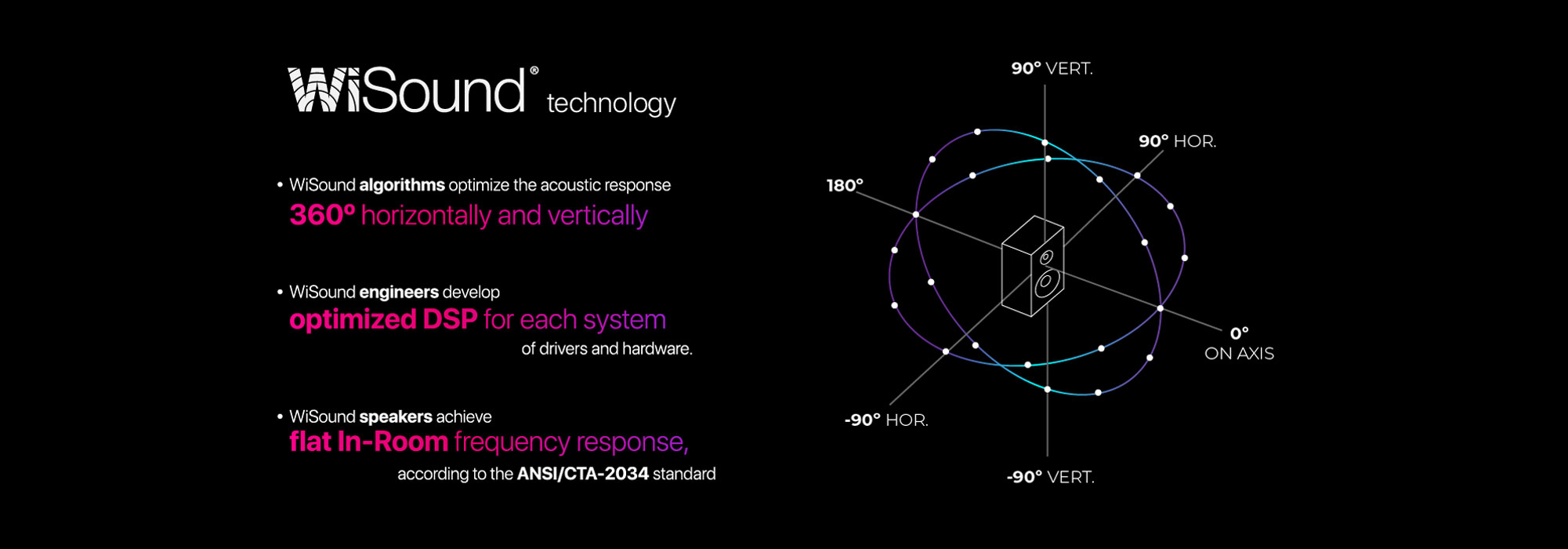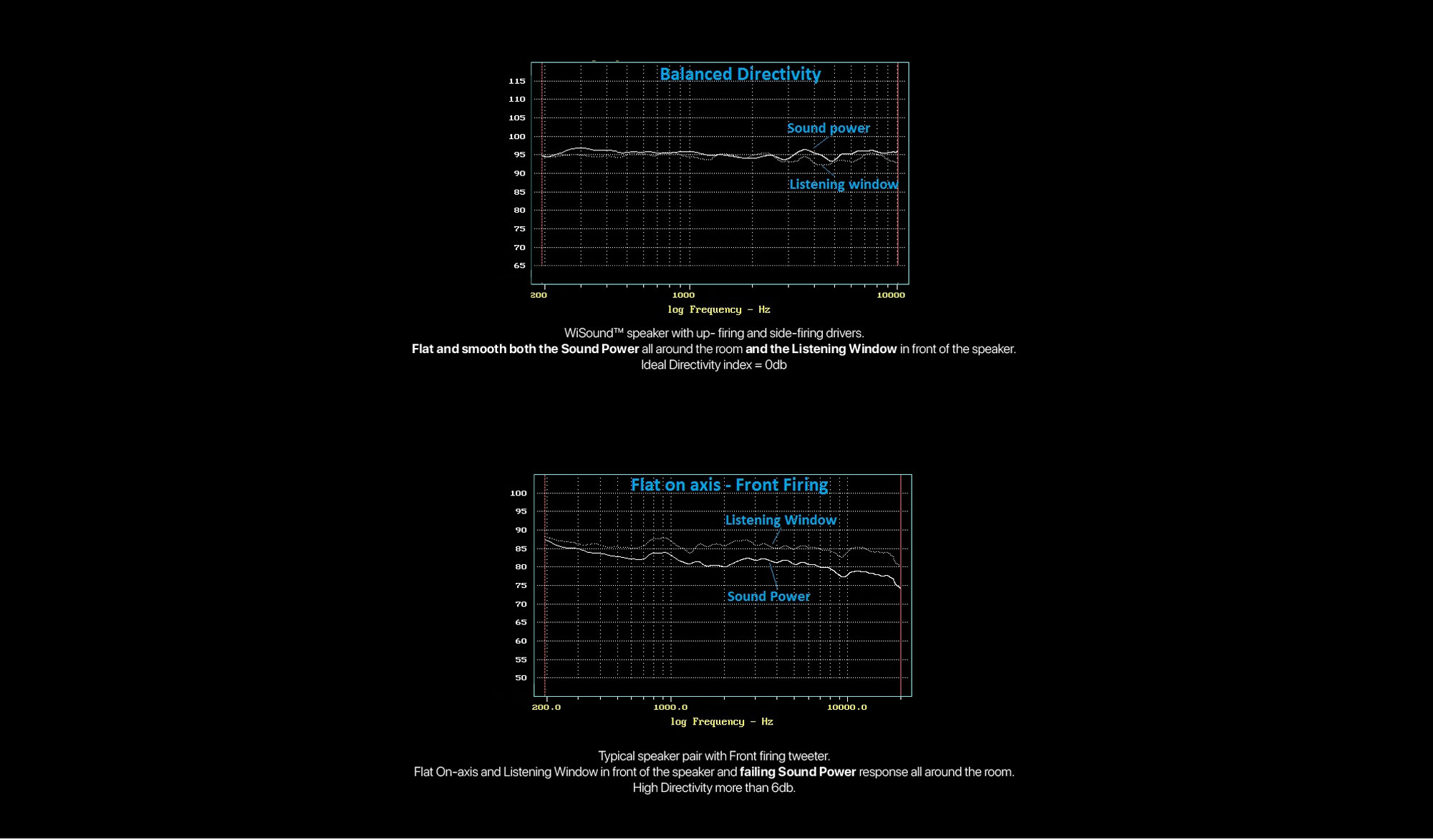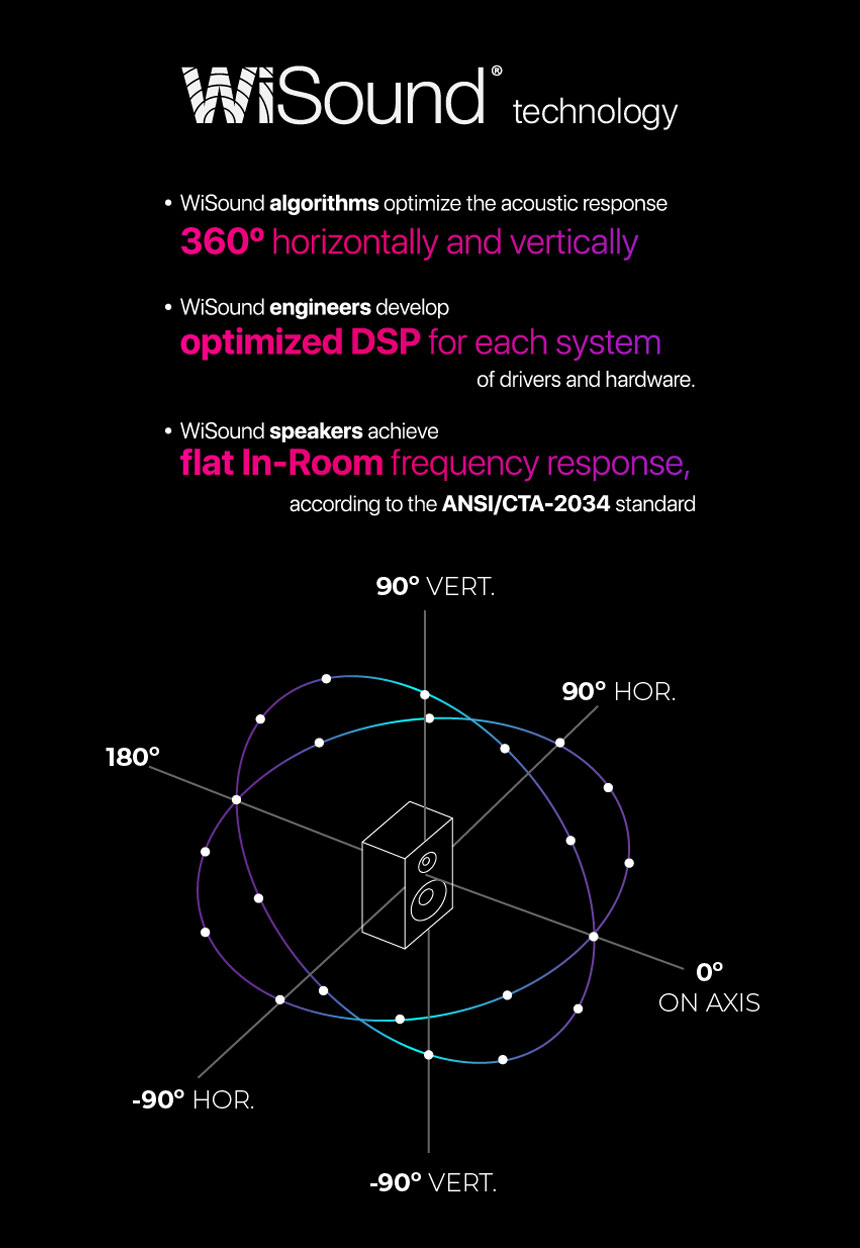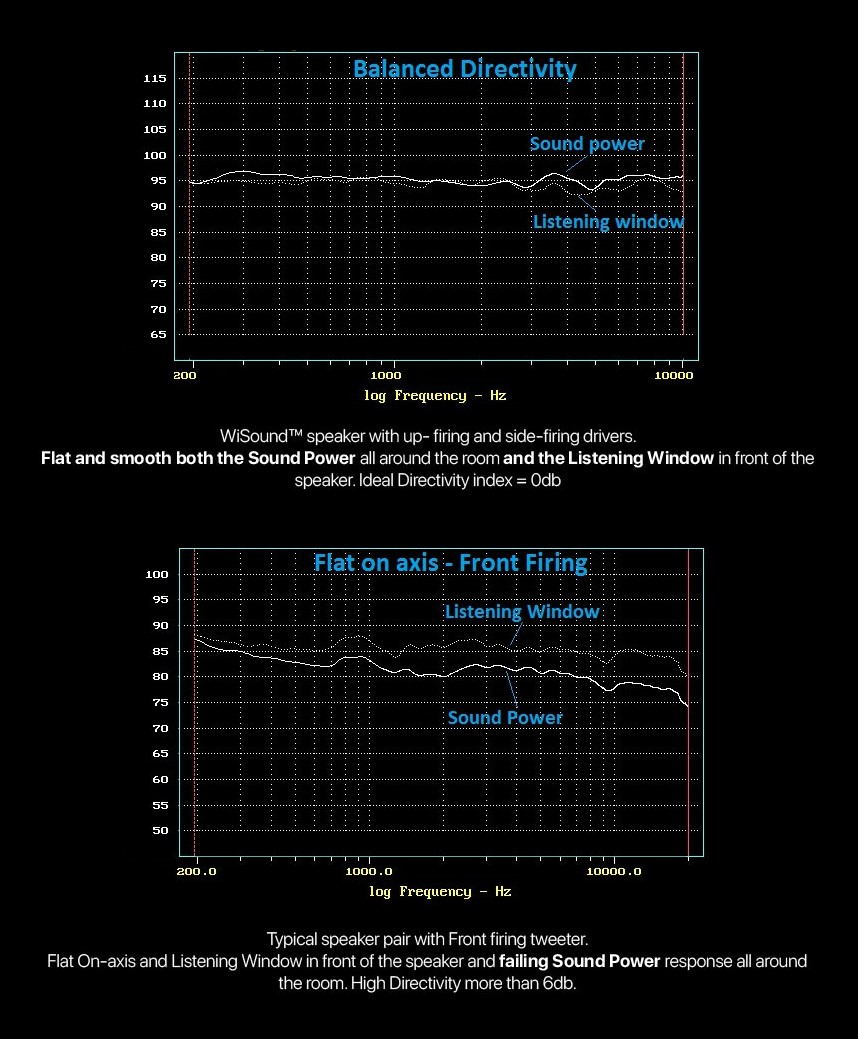There are no products matching the selection.
Balanced Room Response
measured according tothe
ANSI/CTA-2034
Standard/Method of Measurement
for In-Home Loudspeakers
- Balanced 360° Horizontal & Vertical Soundfields
- Smooth Room Reflections for a natural sound without Coloration
- Balanced Sound Everywhere in Any Room
WiSound balances the sound throughout the listening area, not just in the on-axis position in front of the speakers.
Sound Power & On-Axis Response
The failure of speaker designers/manufacturers
to create the perfect loudspeaker has established
two different design trends:
- Flat On-Axis speakers (optimize the Direct Sound)
Flat Sound Power speakers (optimize the Sum of Direct & Reflected Sound)
A. Flat On-Axis speakers sound good only in specific listening positions (Figure above) and best at the Sweet Spot (401).
- According to the ITU-R, Sweet Spot is the apex of an equilateral triangle, with the other two apexes being the speakers L (402) and R (403).
- The soundstage changes when the listener moves away from the Sweet Spot, shifting its center with the listener.
B. In the Flat Sound Power design trend (Figure above (a)), a flat frequency response of the average of the measurements around the listening area (201) is intended.
- The Sound, in this instance, is pleasant, even at positions further from the speakers, where the reflected Sound is stronger than the direct.
- It is especially true in large listening rooms (thanks to its rich reflections that stimulate more evenly in all directions). This experience is closer to live music.
In recent years, the Flat Sound Power design trend has been replaced by the Flat On-Axis.
Typical examples of Flat Sound Power technology are the once very popular studio monitor speakers Yamaha NS-10M (Figure above (a)), the domestic Bose 901 V, Bose 501, Bose 301, etc.
- Despite their long-term efforts, the leading manufacturers did not create speakers with both Flat On-Axis and Flat Sound Power Response.
- The typical speakers are limited because while holding the Power level constant at all frequencies, the On-Axis level continuously rises along with the increasing frequency.
(Patents US 3.582.553, 1 Jun. 1971, «Loudspeaker System» and US 3.727.004, 10 Apr. 1973, «Loudspeaker System»).
WiSound™ Technology with
3D Balanced Directivity Drivers & WiSound DSP
combines the advantages of the previous speaker types
without their limitations.
Advantages:
1. The sound is properly balanced throughout the whole listening area; not just in the on-axis position in front of the speakers. In other words, the sweet spot, from a tight and specific area as it is with the conventional technol- ogy, widens to the dimensions of almost the entire listening area, with the instruments outlined in space, simulating live music listening conditions.
2. The feeling of space is balanced, releasing the audio experience from small listening room limitations, as the reflected sound is stronger than the direct, even in small spaces close to the speaker, but not more than what is needed for the proper feeling of space
3. The sound is perfectly natural and enjoyable, just like in live music.
Apart from the appropriate choice of drivers and their placement as described, special acoustics algorithms de- veloped by WiSound engineers are used.
Lastly, the Estimated In-Room response is identical to the Direct Sound response at all frequencies, thanks to the zero Directivity Index (DI = 0) of WiSound Balanced Directivity speakers.
Full Size Acoustic Sources
Feel the orchestra playing at full size, right in front of you in your room
WiSoundTM technology balances the room reflections so they are uniform with the direct sound image.
WiSoundTM speakers balance the total Sound Power to be at the optimum balanced level with the Direct Sound.
Spherical Response
Natural balanced sound power throughout a wide listening area
Balanced Direct Sound and Reflected Sound response is the ideal response of a good speaker, with both curves being flat and having a similar shape. This is the most important and unique characteristic of our pat- ent-pending WiSoundTM Flat In-Room Response speakers.
Traditional speakers’ optimum performance can only be perceived by a listener sitting in a specific place relative to the speaker(s). All the while, today’s consumers lead a high-paced, individualised and multi-tasking lifestyle that demands flexibility, freedom of movement and products that can be easily situated to accommodate interior design choices.
Traditional speakers don’t fit the bill. So what would make the ideal speaker?
The ideal speaker should have:
· Flat In-Room Response in front of the speaker
· Flat In-Room Response all around the speaker.
Only this way will you have a speaker that delivers the same sound to your ears – wherever you are in the room.
Which means, the usual technique of placing the drivers for the midrange and high frequencies in the front of the speaker does not achieve the ideal speaker.
Conventional speakers with the drivers for midrange and high frequencies placed in the front, can either be Flat On Axis, or have Flat Sound Power Response, but not both at the same time, because of the high frequencies’ directivity, so manufacturers are forced to compromise.
This failure results in an uneven dispersion of the sound in space.
On Axis and Sound Power
The failure of speaker designers / manufacturers to create the perfect loudspeaker has established two different design trends:
· Flat On Axis speakers
· Flat Sound Power speakers
A. Flat On-Axis speakers sound good only in specific listening positions (Figure above), and best at the sweet spot (401) which, according to the ITU-R, is the apex of an equilateral triangle with the other two apexes be the two speakers L (402) and R (403). However, when the listener moves away from the sweet spot the soundstage changes, shifting its centre along with the listener.
B. In the Flat Sound Power design trend (Figure above (a)), a flat frequency response of the average of the measurements around the listening area (201) is intended. The sound in this instance is pleasant, even at positions further from the speakers, where the reflected sound is stronger than the direct, especially in large listening rooms (thanks to its rich reflections that stimulate more evenly in all directions). This experience is closer to live music.
In recent years, the Flat Sound Power design trend has been replaced by the Flat On-Axis. Typical examples of Flat Sound Power technology were the once very popular studio monitor speakers Yamaha NS-10M (Figure above (a)), the domestic Bose 901 V, Bose 501, Bose 301 etc.
One of the most famous and successful researchers and speaker manufacturers is Bose, a company that has presented innovative speaker technology, most notably the direct - reflected sound speakers ( 901, 501, 301 etc ) and smooth Sound Power. The company’s researchers, despite their long-term efforts, did not manage to create speakers with both Flat On-Axis and Flat Sound Power Response, because while they were holding the Power level constant at all frequencies, the On-Axis level was continuously rising along with the increasing frequency. ( Patents US 3.582.553, 1 Jun. 1971, «Loudspeaker System» and US 3.727.004, 10 Apr. 1973, «Loudspeaker System»).
This is the problem that WiSound™ Technology solves.
Crystal Clear Advantages
Best Value for Money
Innovation
Quality
Style
















